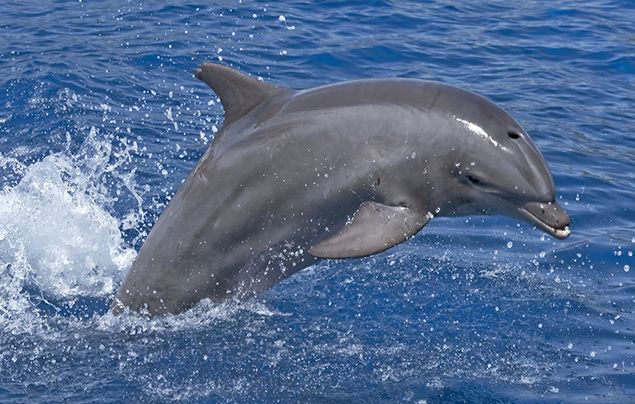Introduction Dolphin Facts: Nature's Intelligent Marine Mammals
Dolphins, typically concerned as among the ocean's most smart residents, display a remarkable selection of behaviors and social structures that warrant closer examination. With over 40 distinctive species, these marine animals not just demonstrate exceptional interaction abilities and facility social interactions however also have advanced cognitive abilities that challenge our understanding of non-human intelligence. Dolphin Facts. As we explore the subtleties of their lives, one must think about how these characteristics influence their communications with humans and journalism importance of preservation. What ramifications do these understandings hold for our relationship with these remarkable creatures?
Dolphin Types Variety
Dolphins are a varied group of marine creatures belonging to the household Delphinidae, which encompasses over 40 unique varieties. This family consists of widely known types such as the usual bottlenose dolphin (Tursiops truncatus), the whale or killer whale (Orcinus whale), and the risso's dolphin (Grampus griseus) Each types exhibits one-of-a-kind physical features, habits, and adjustments that allow them to grow in different aquatic settings.
Dolphin types differ substantially in dimension, ranging from the tiny Maui's dolphin (Cephalorhynchus hectori) at around 1.2 meters to the orca, which can reach lengths of as much as 9 meters. Their coloration also differs, with some types presenting striking patterns that aid with camouflage or social signaling. Furthermore, dolphins occupy varied habitats, from coastal areas and tidewaters to the open sea, showcasing their adaptability.
Research right into dolphin species variety highlights the eco-friendly relevance of these mammals, as they play critical functions in aquatic environments. Understanding the numerous types is vital for preservation initiatives, as numerous deal with risks from habitat climate, air pollution, and loss adjustment, demanding targeted defense measures to ensure their survival.
Social Structures and Actions
The intricacy of dolphin varieties is mirrored in their complex social frameworks and habits. Dolphins are known for their very social nature, usually forming groups called husks, which can vary from a couple of individuals to over a hundred. These shells are generally made up of member of the family, showcasing a matrilineal structure where ladies play a central role in nurturing and maintaining social bonds children.

Furthermore, some varieties of dolphins, such as orcas, demonstrate complex social actions that can consist of sub-pods or clans with distinct cultural techniques. These social structures are important for the survival and wellness of dolphin populations, as they help with interaction, collaboration, and the transmission of knowledge throughout generations. Recognizing these social dynamics is crucial for preservation efforts and the security of their all-natural environments.
Communication Strategies
Amongst the various methods of interaction, dolphins use an advanced selection of interaction methods that help with social communication and control within their shucks. These techniques encompass vocalizations, body language, and echolocation, each offering distinct features in their social interactions.
Dolphins produce a vast array of clicks, whistles, and pulsed audios, which act as their primary singing communication. Each dolphin has an unique signature whistle, akin to a name, that enables individuals to identify each other also in huge groups. These vocalizations can communicate various messages, such as notifying others to threat or collaborating group activities throughout searching.
In addition to articulations, body language plays a crucial function in dolphin interaction. Dolphin useful link stances, such as leaping, rotating, and find even refined changes in positioning, convey moods and objectives. Aggressive screens may prevent rivals, while lively actions can improve social bonds - Dolphin Facts.
Echolocation, an organic finder system, additional aids in navigating and searching. By giving off sound waves and interpreting the returning mirrors, dolphins can situate target and challenges effectively, showing their amazing versatility in complicated aquatic settings. Jointly, these interaction strategies underscore the complex social lives of dolphins, highlighting their knowledge in navigating their underwater globe.

Knowledge and Issue Fixing
Identified for their advanced interaction skills, dolphins likewise display remarkable intelligence and problem-solving capabilities that better enhance their social communications. Their cognitive capacities are evidenced by their capacity to learn complicated jobs, recognize abstract concepts, and adjust to various environmental difficulties. Research study has shown that dolphins can address intricate problems, showing not only their cognitive adaptability but also their capacity for preparation and foresight.
Dolphins frequently involve in cooperative hunting techniques, showcasing their ability to work as a cohesive device. This team effort requires innovative problem-solving abilities, as they should examine their atmosphere, recognize potential victim, and collaborate their activities to achieve an usual goal. Additionally, dolphins have been observed making use of tools, such as marine sponges, to safeguard their noes while foraging on the sea flooring, further exhibiting their cutting-edge analytic capabilities.

Human-Dolphin Communications
Human-dolphin communications have actually astounded lovers and researchers alike, highlighting the complicated partnership between these intelligent aquatic view it now creatures and humans. From ancient times, dolphins have been illustrated in art and folklore, signifying consistency and intelligence (Dolphin Facts). Modern interactions vary from scientific research and preservation initiatives to recreational activities like dolphin enjoying and swimming with dolphins
Research study has demonstrated that dolphins have progressed social frameworks and communication abilities, which promote their communications with human beings. These encounters usually foster psychological connections, with many people reporting feelings of pleasure and compassion throughout such experiences. Nonetheless, it is essential to approach these communications with caution, as human tasks can interfere with dolphin actions and habitats.
Preservation efforts significantly concentrate on advertising responsible communications, guaranteeing that human enthusiasm does not compromise dolphin well-being. Education and learning programs aim to raise recognition regarding the environmental value of dolphins, emphasizing the need for lasting methods.
Conclusion
In summary, dolphins exemplify impressive intelligence and adaptability within varied aquatic atmospheres. Their intricate social frameworks, progressed communication techniques, and analytical capabilities underscore the complexity of their actions. Human communications with these aquatic animals highlight the importance of responsible preservation initiatives to guarantee their survival and the security of their habitats. Proceeded research study and awareness are necessary for cultivating a deeper understanding of dolphins and advertising their well-being in an increasingly intimidated ecosystem.
Dolphin types vary significantly in dimension, ranging from the little Maui's dolphin (Cephalorhynchus hectori) at roughly 1.2 meters to the whale, which can reach sizes of up to 9 meters. Dolphins display a selection of social interactions, consisting of grooming and physical get in touch with, which serve to strengthen relationships and develop hierarchies.
Acknowledged for their innovative communication abilities, dolphins additionally display amazing knowledge and analytical capacities that even more enhance their social interactions. Modern interactions range from scientific research and conservation efforts to leisure activities like dolphin swimming and enjoying with dolphins.
Study has shown that dolphins have advanced social structures and interaction abilities, which promote their communications with people.
 Luke Perry Then & Now!
Luke Perry Then & Now! Michelle Pfeiffer Then & Now!
Michelle Pfeiffer Then & Now! Bug Hall Then & Now!
Bug Hall Then & Now! Suri Cruise Then & Now!
Suri Cruise Then & Now! Andrew McCarthy Then & Now!
Andrew McCarthy Then & Now!